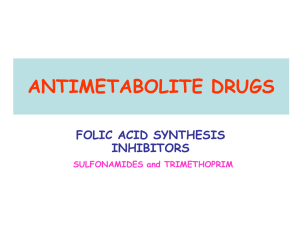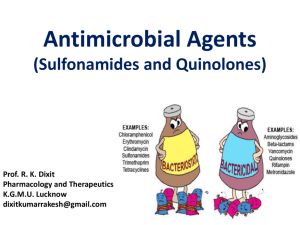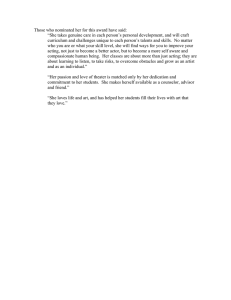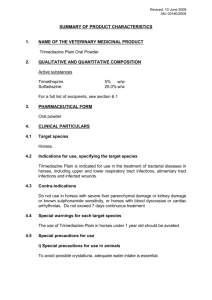Sulphonamides: Antibacterial Agents - Mechanism, Uses, & Effects
advertisement
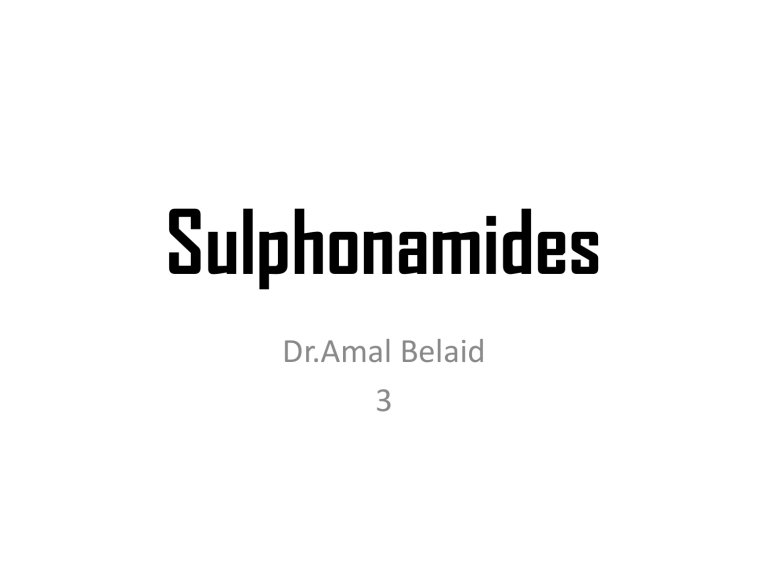
Sulphonamides Dr.Amal Belaid 3 One of the oldest antibacterial agents used to combat infection Used for coccal infection in 1935 They are bacteriostatic because it inhibits bacterial synthesis of folic acid Clinical usefulness has decreased because of the effectiveness of other antibiotics and penicillin • Building on Ehrlich’s early work, Gerhard Domagk, a medical doctor employed by a German dye manufacturer made a breakthrough discovery by finding that a dye known as prontosil, dosed orally, was effective in curing life threatening streptococci infections in humans. He made the discovery in a desperate, but successful attempt to save his daughter who was dying of a streptococci infection. First compounds found to be effective antibacterial agents in safe dose ranges. Chemically, it is a molecule containing the sulfonamido (sulfanilamide, SO2NH2) functional group attached to an aniline. Structurally related to p-amino benzoic acid (PABA). This group is also present in other non-antibacterial compounds like Sulphonureas -Benzothiazids -Furosemide -Acetazolamide They act as antimicrobial agents by inhibiting bacterial growth and activity and commonly called sulfa drugs. Chemical modification of the sulphonamide structure has given rise to several important group of drugs. Gloucoma – Acetazolamide Diuretic – Thiazides Anti-mycobacterial – Sulphones Oral hypoglycemic – Sulphonyl ureas Mechanism of action Competitive inhibitor to dihydropteroate synthase enzyme due to resemblance with para-amino benzoic acid. Sulfonamides therefore are reversible inhibitors of folic acid synthesis and bacteriostatic not bactericidal. Inhibit bacterial growth without affecting normal cells Sulfonamide molecular structure is similar to p-Amino benzoic acid (PABA) which is needed in bacteria organisms as a substrate of the enzyme dihydro pteroate synthetase for the synthesis of Tetra Hydro Folic acid (THF). Folic acid - synthesized from PABA, pteridine and glutamate. All sulfonamides are analogs of PABA. All sulfa drugs are bacteriostatic Antibacterial activity • Gram-positive and gram negative. • Nocardia, chlamydia trachomatis, some protozoa. Classification of SA A. Sulphonamides employed for treatment of systemic infection. Depending upon duration , they can be further subdivided into: a) Short to intermediate acting sulphonamides. Sulfadiazine (Short acting sulfonamide)• Absorption: Rapid oral absorption. It has good penetrability inbrain and CSF-was the preferred compound for meningitis.• Metabolism: Liver by acetylation. It is 50% plasma proteinbound and 20-40% acetylated.• Excretion: Trough urine. Sulfamethoxazole (Intermediate acting)• Absorption: Slow oral absorption. It is the Preferredcompound for combining with trimethoprim because the t1/2of both is similar.• Metabolism: Liver by acetylation.• Excretion: Trough urine. Acetylated fraction ofsulfamethoxazole is relatively insolublecrystalluria can occur Sulfadoxine, Sulfamethopyrazine(Long acting)• These are ultralong acting compounds, action lasting > 1 weekbecause of high plasma protein binding and slow renalexcretion (t1/2 5-9 days).• They attain low plasma concentration (of free form) and arenot suitable for treatment of acute pyogenic infections. Theyare used in combination with pyrimethamine in the treatmentof malaria Sulfacetamide sodium(Special purpose sulfonamides)• Highly soluble compound - Mildly irritating to the eye(concentrations up to 30%).• Used topically for ocular bacterial infections and chlamydia Sliver sulfadiazine(Special purpose sulfonamides)• Its act against large number of bacteria and fungi, even thoseresistance to other sulfonamides (e.g.: Pseudomonas).• Slow releases silver ions which appear to be largelyresponsible for the antimicrobial action. B. Long acting sulphonamides C. Extra long acting sulphonamides 2. Poorly absorbed sulphonamides 3. Topically used sulphonamides Structure activity relationship General 1.Sulphonamide skeleton is the minimum structural requirement for antibacterial activity. 2.The active form of sulphonamide is the ionized form. Maximum activity is observed bretween the pka value 6.6-7.4. 3. Sulphonamides competes for binding site on plasma albumin with causes increased action of drugs like Aspirin, Phenylbutazone, methotrexate etc. Therapeutic uses • Urinary tract infections • Upper respiratory tract infections • Nocardiosis • Sulfasalazine in IBD. • Sulfacetamide in bacterial conjunctivitis & trachoma • Silver sulfadiazine for prevention of infection of burn wounds . Adverse effects • Hypersensitivity reactions • Crystalluria,hematuria,renal obstruction. • Allergic nephritis • Haemolytic anaemia, aplastic anaemia, thrombocytopenia. • Kernicterus in new born Trimethoprim - Sulfamethoxazole combination (Co-trimoxazole) Mechanism of action: Sequential blocking of purine synthesis (synergism). Trimethoprim inhibits dihydrofolate reductase enzyme so inhibits tetrahydrofolic acid synthesis The combination is bactericidal
